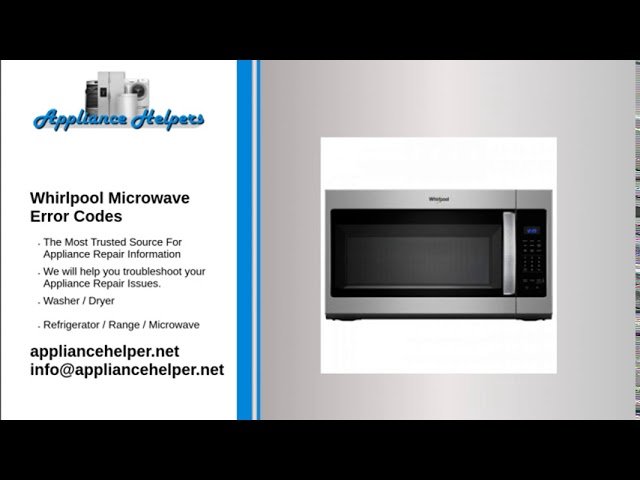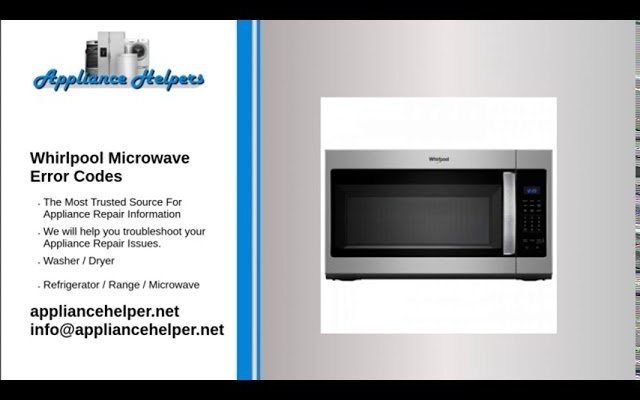
The “OE” error code on Whirlpool microwaves isn’t as mysterious as it seems. It’s the machine’s way of waving a red flag, whispering (or perhaps yelling), “Hey, something’s not quite right here!” These kinds of codes are designed to help us figure out what’s wrong so we can fix the problem without too much hassle. Let’s break down what causes this error and how you can tackle it like a pro.
Understanding the “OE” Error Code
You might be wondering, what exactly is this “OE” error code trying to tell you? Simply put, the “OE” code usually signifies an issue with the microwave’s hood fan system. The hood fan, also known as the exhaust fan, is crucial. It helps in venting out steam and smoke, particularly when you’re cooking up a storm on your stove. When something goes amiss, the microwave is smart enough to signal you with the error code.
Now, let’s talk about what could go wrong. One possible cause might be a faulty fan motor. Imagine the fan motor as the heart of your microwave’s ventilation system; if it stops working, everything else does too. This is akin to a car engine that refuses to start — your microwave can’t breathe out the steam, and the operation might halt. Another culprit could be restricted airflow. Think of this like a blocked nose when you have a cold; if the pathways are blocked, the fan can’t do its job efficiently.
And then there’s the possibility of a miscommunication between the control board and the fan. The control board is the brain of your microwave. If the signals get crossed, it could mistakenly interpret that the fan isn’t working correctly, even if it is! So, before you panic, keep in mind that it might just be a misunderstanding between the microwave’s components.
Causes Related to Mechanical Issues
Mechanical issues are often at the heart of the “OE” error code. One of the most common mechanical problems is a malfunctioning fan motor. Picture this: the fan motor is like the wind beneath the wings of your microwave. When it stops working, the hood fan won’t be able to clear steam or smoke, leading to an error. This failure can happen due to wear and tear or a sudden surge in power that damages the motor.
Another mechanical hiccup could be a clogged air filter. Over time, dust and grease accumulate in the air filter, just like lint in a dryer filter. This dirt buildup can restrict airflow, leading to overheating and eventually causing the “OE” error code to appear. Regular cleaning and maintenance of the filter can prevent this common issue.
Furthermore, if there’s any damage to the fan blades — maybe from accidental impact or overuse — that could cause the fan to run inefficiently. It’s similar to when a spinning top is off balance; it doesn’t quite spin the way it should. Ensuring the fan blades are intact and correctly aligned can save you from the pesky “OE” error in the future.
Electrical Malfunctions and Miscommunications
When it comes to electrical malfunctions, things can get a little tricky. One potential cause is a failure in the microwave’s control board. This board is like the command center, telling every part of the microwave what to do and when to do it. If there’s a short circuit or a burnt-out component on the board, it could incorrectly signal the fan to stop working, even if everything else seems fine.
There’s also the issue of faulty wiring. Imagine your microwave as a city network and the wires as the roads that connect everything. If a road is broken or blocked, traffic (or in this case, electricity) can’t flow to its destination. This can cause the fan not to receive the necessary power, leading to the “OE” error code. Ensuring all wires and connections are intact can help prevent such problems.
Additionally, software glitches might occur, although they’re less common in microwaves compared to computers or smartphones. However, a momentary lapse in the microwave’s programming could cause it to misinterpret signals, hence flashing the error code. A simple reset or unplugging and re-plugging the appliance might resolve this issue, just as restarting a computer fixes many tech problems.
How to Solve and Prevent Future Errors
Here’s the deal: fixing the “OE” error might seem daunting, but with a little patience and understanding, you can tackle it. Start by checking the obvious — make sure the air filter is clean and the fan is free from obstructions. Give the air filter and the fan some much-needed TLC by cleaning them regularly. Like changing the oil in a car, keeping the microwave clean ensures everything runs smoothly.
If you’re not seeing any improvement, consider calling a professional. A certified technician can inspect the internal components, like the fan motor and control board, to diagnose any underlying issues. It’s always better to be safe than sorry, especially when dealing with electrical appliances.
Preventing future “OE” error codes can be as simple as regular maintenance. Keep your microwave clean, ensure proper ventilation, and avoid overloading the appliance with large amounts of steam or smoke from stovetop cooking. Treat your microwave well, and it’ll treat you well in return. If all else fails, remember that the Whirlpool customer support team is just a call away, ready to help you get back to your microwave meals in no time!
